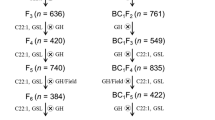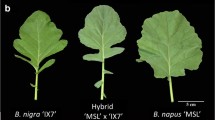Abstract
Key message
First report for the resynthesis of Brassica napus by recombining A and C genome from B. juncea and B. carinata , respectively. Also documents B genome introgressions in resynthesized B. napus.
Abstract
Resynthesis of Brassica napus (AACC) was achieved by hybridizing Brassica juncea (AABB) with Brassica carinata (BBCC). This was facilitated by spontaneous chromosome doubling in the F1 hybrid (ABBC) to yield octaploid (AABBBBCC), elimination of extra B genome chromosomes in the resulting octaploid and in subsequent selfed generations, aided with directed selection for fertile plants having B. napus morphology. Twenty-five plants with varying degrees of resemblance to natural B. napus were identified from 17 A5 progenies and assayed for cytogenetic stability and genetic diversity. Majority of these plants, except six (2n = 38) were hyperploids (2n = 40–56). The six plants with 2n = 38 were designated as derived B. napus types. These showed an expected meiotic configuration of 19II at metaphase-I, with 19−19 distribution at anaphase-I. Genotyping based on A and C genome specific primers confirmed genetic identity of six derived (2n = 38) B. napus plants with natural types whereas genotyping with B genome specific primers indicated introgression of B genome segments. This was also confirmed by genomic in situ hybridization (GISH). Strong signals of B genome probe were detected, proving hitherto unreported genetic exchanges between B and A/C chromosomes. These introgressions possibly occurred en route five generations of selfing. Derived plants yielded fertile hybrids in crosses with natural B. napus var. GSC 6. The selfed derived plants as evaluated in A6 plant to progeny rows were morphologically similar to natural B. napus, and meiotically stable. Agronomic assessment of these progenies revealed variation for key morpho-physiological traits. Of special interest were the progenies with plants having oil content exceeding 47 % as against about 39–41 % in existing cultivars.







Similar content being viewed by others
References
Banga SS, Kaur N (2009) An alternate procedure for resynthesis of Brassica juncea. In: Proceedings of the 16th Australian Res. Assembly Brassicas Ballarat Victoria, pp 1–4
Chalhoub B, Denoeud F, Liu S et al (2014) Early allopolyploid evolution in the post-neolithic Brassica napus oilseed genome. Science 345:950–953
Chen X, Li M, Shi J, Fu D, Qian W, Meng J (2008) Analysis on gene expression profile of intersubgenomic hybrids and their parents in Brassica napus. Theor Appl Genet 117:1031–1040
Dixelius C, Wahlberg S (1999) Resistance to Leptosphaeria maculans is conserved in a specific region of the Brassica B genome. Theor Appl Genet 99:368–372
Doyle JJ, Doyle JL (1990) Isolation of plant DNA from fresh tissue. Focus 12:13–15
Fredua-Agyeman R, Coriton O, Huteau V, Parkin IAP, Chèvre AM, Rahman H (2014) Molecular cytogenetic identification of B genome chromosomes linked to blackleg disease resistance in Brassica napus × B. carinata interspecific hybrids. Theor Appl Genet 127:1305–1317
Friedt W, Luhs W, Muller M, Ordon F (2003) Utility of winter oilseed rape (Brassica napus L.) cultivars and new breeding lines for low-input cropping systems. German J Agron 2:49–55
Fu D, QianW Zou J, Meng J (2012) Genetic dissection of intersubgenomic heterosis in Brassica napus carrying genomic components of B. rapa. Euphytica 184:151–164
Gaeta RT, Pires JC (2010) Homoeologous recombination in allopolyploids: the polyploidy ratchet. N Phytol 186:18–28
Girke A, Becker HC, Enqvist GM (1999) Resynthesized rapeseed as a new gene pool for hybrid breeding. In: Proc 10th international rapeseed congress. 26–29 September. Canberra, Australia. CD-Rom
Gupta M, Atri C, Banga SS (2014) Cytogenetic stability and genome size variations in newly developed derived Brassica juncea allopolyploid lines. J Oilseed Brassica 5:118–127
Gupta M, Gupta S, Kumar H, Kumar N, Banga SS (2015) Population structure and breeding value of a new type of Brassica juncea created by combining A and B genomes from related allotetraploids. Theor Appl Genet 128:221–234
Hasan M, Seyis F, Badani AG, Pons-Kuhnemann J, Friedt W, Luhs W, Snowdon RJ (2006) Analysis of genetic diversity in the Brassica napus L. gene pool using SSR markers. Genet Res Crop Evol 53:793–802
Heath DW, Earle ED (1996a) Resynthesis of rapeseed (Brassica napus L.): a comparison of sexual versus somatic hybridization. Plant Breed 115:395–401
Heath DW, Earle ED (1996b) Synthesis of Ogura male sterile rapeseed (Brassica napus L.) with cold tolerance by protoplast fusion and effects of atrazine resistance on seed yield. Plant Cell Rep 15:939–944
Kim H, Choi SR, Bae J (2009) Sequenced BAC anchored reference genetic map that reconciles the ten individual chromosomes of Brassica rapa. BMC Genom 10:432
Kraling K (1987) Utilization of genetic variability of resynthesized rapeseed. Plant Breed 99:209–217
Lagercrantz U (1998) Comparative mapping between Arabidopsis thaliana and Brassica nigra indicates that Brassica genomes have evolved through extensive genome replication accompanied by chromosome fusions and frequent rearrangements. Genetics 150:1217–1228
Li M, Qian W, Meng J, Li Z (2004) Construction of novel Brassica napus genotypes through chromosomal substitution and elimination using interploid species hybridization. Chromosome Res 12:417–426
Lu C, Kato M (2001) Fertilization fitness and relation to chromosome number in interspecific progeny between Brassica napus and B. rapa: a comparative study using natural and resynthesized B. napus. Breed Sci 51:73–82
Luhs W, Seyis F, Baetzel R, Friedt W (2003) Genetic diversification of Brassica napus seed quality by wide hybridization. In: Proceedings of the 11th International Rapeseed Congress, pp 375–377. Copenhagen, Denmark
Lysak MA, Koch MA, Pecinka A, Schubert I (2005) Chromosome triplication found across the tribe Brassiceae. Genome Res 15:516–525
Navabi ZK, Parkin IAP, Pires JC, Xiong Z, Thiagarajah MR (2010) Introgression of B-genome chromosomes in a doubled haploid population of Brassica napus × B. carinata. Genome 53:619–629
Navabi ZK, Stead KE, Pires CJ, Xiong Z, Sharpe AG, Parkin IAP, Rahman MH, Good AG (2011) Analysis of B-genome chromosome introgression in interspecific hybrids of Brassica napus × B. carinata. Genetics 187(3):659–673
Ozminkowski RH, Jourdan P (1994a) Comparing the resynthesis of Brassica napus L. by interspecific, somatic and sexual hybridization. I. Producing and identifying hybrids. J Am Soc Hort Sci 119:808–815
Ozminkowski RH, Jourdan P (1994b) Comparing the resynthesis of Brassica napus by interspecific, somatic and sexual hybridization hybrid morphology and identifying organelle genomes. J Am Soc Hort Sci 119:816–823
Perrier X, Flori A, Bonnot F (2003) Data analysis methods. In: Hamon P, Seguin M, Perrier X, Glaszmann JC (eds) Genetic diversity of cultivated tropical plants. Science Publishers, Montpellier, pp 43–76
Prakash S, Chopra VL (1991) Cytogenetics of crop Brassicas and their allies. Chromosome engineering in plants: genetics breeding evolution. Elsevier Science Publishers, Amsterdam, pp 161–180
Prakash S, Wu XM, Bhat SR (2011) History, evolution, and domestication of Brassica crops. Plant Breed Rev 35:19–84
Ralph van Berloo R (2008) GGT 2.0: versatile software for visualization and analysis of genetic data. J Heredity 99:232–236
Schelfhout CJ, Snowdon R, Cowling WA, Wroth JM (2006) Tracing B-genome chromatin in Brassica napus x Brassica juncea interspecific progeny. Genome 49:1490–1497
Schwarzacher T, Heslop-Harrison P (2000) Practical In situ Hybridization. BIOS Scientific Publishers, Oxford, p 203
Seyis F, Snowdon RJ, Luhs W, Friedt W (2003) Molecular characterization of novel resynthesized rapeseed (Brassica napus) lines and analysis of their genetic diversity in comparison with spring rapeseed cultivars. Plant Breed 12:473–478
Seyis F, Friedt W, Luhs W (2005) Development of resynthesized rapeseed (Brassica napus L.) forms with low erucic acid content through in ovulum culture. Asian J Pl Sci 4:6–10
Song KM, Tang K, Osborn TC (1993) Development of synthetic Brassica amphidiploids by reciprocal hybidization and comparision to natural amphidiploids. Theor Appl Genet 86:811–821
Song KM, Lu P, Tang KL, Osborn TC (1995) Rapid genome change in synthetic polyploids of Brassica and its implications for polyploid evolution. Proc Natl Acad Sci USA 92:7719–7723
Stewart A (2004) A review of crossing relationship between cultivated Brassica species. Cruciferae Newsl 25:25–26
Szadkowski E, EberV Uteau H, Mode L, Uneau C, Belcram H, Coriton O et al (2010) The first meiosis of resynthesized Brassica napus, a genome blender. N Phytol 186:102–112
Tonosaki K, Akaba M, Bang SW, Kitashiba H, Kaneko Y, Nishio T (2014) The use of species-specific DNA markers for assessing alien chromosome transfer in Brassica rapa and Brassica oleracea monosomic additions of Raphanus sativus. Mol Breed 34:1301–1311
Warwick SI, Black LD (1991) Molecular systematics of Brassica and allied genera (Subtribe Brassicinae, Brassiceae): chloroplast genome and cytodeme congruence. Theor Appl Genet 82:81–92
Zou J, Zhu J, Huang S, Tian E, Xiao Y, Fu D, Tu JX, Fu TD, Meng J (2010) Broadening the avenue of inter subgenomic heterosis in oilseed Brassica. Theor Appl Genet 120:283–290
Zou J, Fu D, Gong H, QianW Xia Q, Pires CJ, Li RY, Long Y, Mason AS, Yang TJ, Lim YP, Park BS, Meng J (2011) De novo genetic variation associated with retrotransposon activation, genomic rearrangements and trait variation in a recombinant inbred line population of Brassica napus derived from interspecific hybridization with Brassica rapa. Plant J 68:212–224
Acknowledgments
We are grateful to Pat Heslop-Harrison and Trude Scharzacher for actually teaching us the technique of genomic in situ hybridization during their visit to our laboratory in 2012.
Author information
Authors and Affiliations
Corresponding author
Ethics declarations
Conflict of interest
The authors declare that they have no conflict of interest.
Funding information
Researches were carried out with the financial assistance from Grains Research & Development Corporation, Australia under the research project “Expanding the Brassica Germplasm Base through collaboration with China and India” awarded to Shashi Banga. SSB acknowledges salary support from Indian Council of Agricultural Research.
Additional information
Communicated by C. F. Quiros.
Electronic supplementary material
Below is the link to the electronic supplementary material.
122_2016_2677_MOESM1_ESM.tif
Supplementary file 1 Meiotic configurations in hyperploid segregants: (a) 17II+1I, (b) 16II+3I, (c) 15II+5I, (d) 25II+5I, (e) 24II+4I,(f) early anaphase with 56 chromosomes, (g) 22II+2I, (h) 18II+4I. (i) 20II, (j) 19II+2I, (k) Pollen stainability of derivedB. napus (l) Pollen stainability of aberrant samples (TIFF 7217 kb)
122_2016_2677_MOESM4_ESM.tif
Supplementary file 4 Projected patterns of B genome chromatin substitutions in A genome chromosomes of derived B. napus (TIFF 1416 kb)
122_2016_2677_MOESM5_ESM.tif
Supplementary file 5 Projected patterns of B genome chromatin substitutions in A genome chromosomes of derived B. napus (TIFF 1416 kb)
122_2016_2677_MOESM6_ESM.tif
Supplementary file 6 Projected patterns of B genome chromatin substitutions in C genome chromosomes of derived B. napus (TIFF 1477 kb)
122_2016_2677_MOESM7_ESM.tif
Supplementary file 7 Projected patterns of B genome chromatin substitutions in C genome chromosomes of derived B. napus (TIFF 701 kb)
Rights and permissions
About this article
Cite this article
Chatterjee, D., Banga, S., Gupta, M. et al. Resynthesis of Brassica napus through hybridization between B. juncea and B. carinata . Theor Appl Genet 129, 977–990 (2016). https://doi.org/10.1007/s00122-016-2677-3
Received:
Accepted:
Published:
Issue Date:
DOI: https://doi.org/10.1007/s00122-016-2677-3




